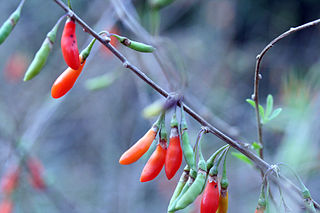
Goji, goji berry, or wolfberry is the fruit of either Lycium barbarum or Lycium chinense, two closely related species of boxthorn in the nightshade family, Solanaceae. L. barbarum and L. chinense fruits are similar but can be distinguished by differences in taste and sugar content.

Lycium is a genus of flowering plants in the nightshade family, Solanaceae. The genus has a disjunct distribution around the globe, with species occurring on most continents in temperate and subtropical regions. South America has the most species, followed by North America and southern Africa. There are several scattered across Europe and Asia, and one is native to Australia. Common English names for plants of this genus include box-thorn and desert-thorn.

Lycium barbarum is a shrub native to China, with present-day range across Asia and southeast Europe. It is one of two species of boxthorn in the family Solanaceae from which the goji berry or wolfberry is harvested, the other being Lycium chinense.

Lycium chinense is one of two species of boxthorn shrub in the family Solanaceae. Along with Lycium barbarum, it produces the goji berry ("wolfberry"). Two varieties are recognized, L. chinense var. chinense and L. chinense var. potaninii. It is also known as Chinese boxthorn, Chinese matrimony-vine, Chinese teaplant, Chinese wolfberry, wolfberry, and Chinese desert-thorn.
FreeLife International is an American multi-level marketing company established in 1995 by Ray Faltinsky and Kevin Fournier that supplies dietary supplements.
Microlechia is a genus of moths in the family Gelechiidae.

Scrobipalpa is a genus of moths in the family Gelechiidae. Euscrobipalpa has sometimes been treated as a distinct subgenus, or even as a full genus, but is generally no longer recognised as valid, following Ponomarenko & Park (2007).
Coleophora neolycii is a moth of the family Coleophoridae which is endemic to China (Ningxia).
Coleophora ningxiana is a moth of the family Coleophoridae which is endemic to China (Ningxia).
Coleophora mosasaurus is a moth of the family Coleophoridae. It is found in the Chinese provinces of Shaanxi and Qinghai and in Turkmenistan.
Scrobipalpa portosanctana is a moth of the family Gelechiidae. It was described by Henry Tibbats Stainton in 1859. It is found in Spain, France, Italy, Croatia, as well as on Sardinia, Corsica, Sicily, Malta and Madeira. It is also present in North Africa and the Near East.
Microlechia chretieni is a moth in the family Gelechiidae. It was described by Turati in 1924. It is found on the Canary Islands, Madeira, Crete and Sardinia, as well as in North Africa, France, Portugal, Spain, Greece and Palestine. It is also present in Saudi Arabia, southern Iran, western Pakistan, Mozambique, Namibia and South Africa.
Microlechia klimeschi is a moth in the family Gelechiidae. It was described by Povolný in 1972. It is found on the Canary Islands.
Microlechia lyciella is a moth in the family Gelechiidae. It was described by Mark I. Falkovitsh and Oleksiy V. Bidzilya in 2003. It is found in Uzbekistan.
Microlechia rhamnifoliae is a moth in the family Gelechiidae. It was described by Hans Georg Amsel and Erich Martin Hering in 1931. It is found on the Canary Islands and Cyprus, as well as in Morocco, Greece, Israel, Palestine, Saudi Arabia, Namibia and South Africa.
Scrobipalpa erichi is a moth in the family Gelechiidae. It was described by Povolný in 1964. It is found in Austria, Slovakia, the Czech Republic, Hungary, Romania, North Macedonia, Moldova, Ukraine, the Middle East, China, Iran, and Mongolia.
Scrobipalpa parki is a moth in the family Gelechiidae. It was described by Povolný in 1993. It is found in Korea and China.
Scrobipalpa erichiodes is a moth in the family Gelechiidae. It was described by Oleksiy V. Bidzilya and Hou-Hun Li in 2010. It is found in China in Gansu, Hebei, Heilongjiang, Ningxia, Inner Mongolia, Shaanxi and Xinjiang.
Scrobipalpula lycii is a moth in the family Gelechiidae. It was described by Powell and Povolný in 2001. It is found in North America, where it has been recorded from California.



